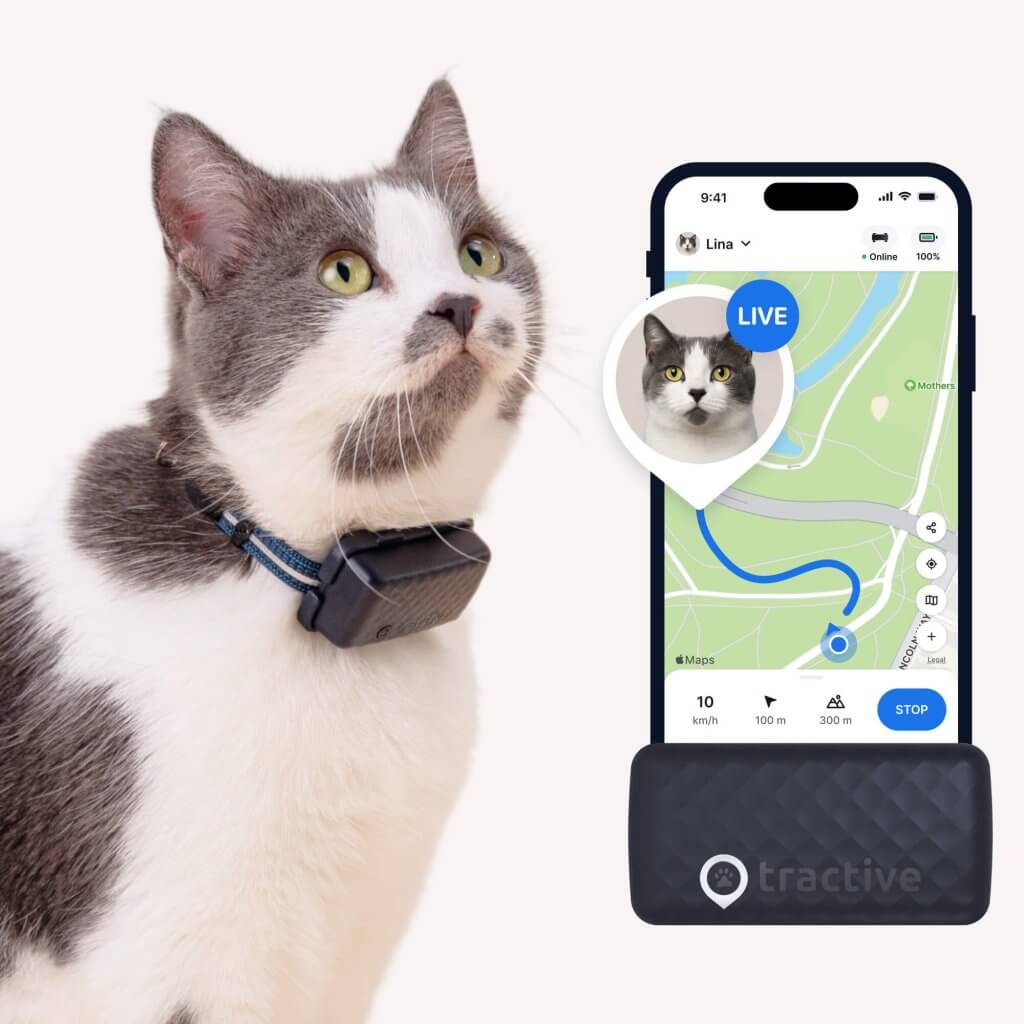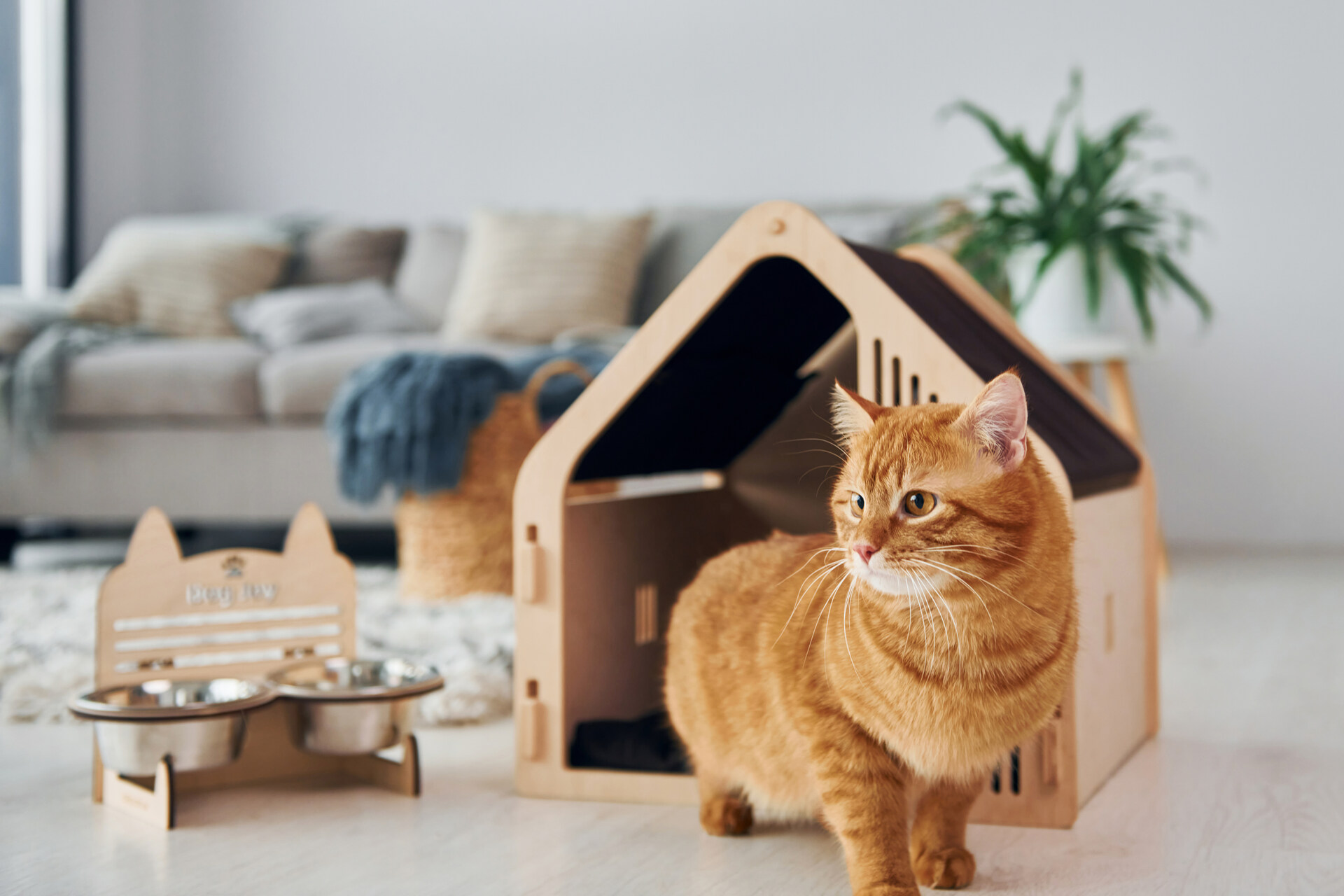Want To Adopt a Cat? What To Expect & How To Prep
Adopting a cat can be one of the most rewarding decisions you'll ever make. Here's how to get started, what to expect, & how to keep them safe for a lifetime of cuddles by your side!

Whether you’re looking to adopt a kitten or a grand-cat, it can be one of the most rewarding decisions you’ll ever make. But is it as easy as taking in one from a street alley and expecting everything to go smoothly? Not quite. Here’s everything you need to know about adopting a cat – how to go about it, how much it might cost you, and how to create the safe, loving home environment your new buddy needs. (And what to do if you do come home to find them missing.)
Key Takeaways
You can adopt a cat from a shelter or a rescue group. But before you do, consider if a kitten or an adult cat would be a better fit for you and your family.
Give your new cat time to get used to their new home and family. It’s a good idea to let them explore just one room at first. (Before letting them roam around the whole house.)
The adoption fee you pay at a shelter usually covers your cat’s first vet check-up, shots, and a microchip to help you find them if they ever get lost.
If you want to make sure your new cat is always safe, you can use a Tractive smart cat collar. It can help you find them if they get lost or hide in your house. Or set up a “safe zone” so you get an escape alert if they leave the yard.

Find out where your cat spends their time.
Read moreWhy adopt a cat?
Adopting a cat means giving a homeless animal a loving forever home. Shelters are often overcrowded with cats of all ages, breeds, and personalities – all looking for a second chance. Why not with you? By adopting a shelter cat, you’d also be doing your part in supporting animal welfare and reducing overpopulation. Besides, adopting a cat might even improve your health! Having one around can greatly reduce stress and feelings of loneliness.
How to adopt a cat: The FAQs covered
Where can I adopt a cat?
In general, we’d always recommend looking for reputable cat adoption centers and shelters near you. These organizations usually include websites where you can filter by cats’ age, breed, gender, their previous family experience, whether they’re house-trained, and also whether they’re indoor or outdoor cats. Here are a couple of good choices when it comes to adopting a cat properly and ensuring their well-being once you’ve brought them home:
- Your local animal shelter or humane society, most of which usually have a whole bunch of cats ready for adoption.
- Cat-specific rescue organizations which focus on rehoming cats. These might also provide specialized care for cats of specific breeds, senior cats, or cats with special needs.
- Websites like Petfinder can help you search for adoptable cats near you, providing detailed profiles for each cat – including their temperament, health status, and adoption requirements.
How old do you have to be to adopt a cat?
Most shelters and rescues require an adopter to be at least 18 years old – but it might depend on the organization itself. Some might have stricter requirements (including your employment details). Always make sure to check your organization’s specific requirements, including whether you need a parent or guardian to co-sign the adoption papers. Once the ink’s dried, you’re now legally responsible for your cat – and their safety and well-being are now entirely in your hands.
How much does it cost to adopt a cat?
Depending on how old your newly adopted cat is, plus factors like their breed, health, and other services – your adoption fees might range from $39-$317 (according to the Animal Humane Society.) In some cases, you might be charged an administrative fee for all adoptions, ranging from $5-$22. (Covering some of the costs incurred by processing the adoption.) But besides that, your adoption fees uusally cover:
- Basic veterinary care, including a general physical examination by trained medical staff.
- Vaccinations, including against rabies.
- Medications
- Microchipping in some cases
- Surgeries, including getting your cat spayed or neutered, if necessary
- A return period
In some cases, your adoption centre might also throw in a free collar and ID tag to help make your cat easy to identify. (Which can be a lifesaver if they get lost!)

And that’s just your initial costs. Your ongoing adoption costs might include:
- Food and water supplies, including high-quality durable bowls and vet-approved cat food options.
- A litter box for your cat
- Scratching posts and toys to keep your new buddy occupied
- Comfortable bedding where your cat can sleep safely
- A carrier, which will come in handy when you’re out driving your cat to the vet or on other trips
Should I adopt an adult cat or a kitten?
Generally, it depends on your time, energy, and resources. Adult cats might be more accustomed to living with families, including other animals and children. So it’s possible they might be house-trained and adjust a (tiny) bit quicker than kittens. For kittens, however, be prepared to invest more time and energy in house-training them and helping them learn to adjust from scratch. Finally, senior cats might seem more “chill” and low-maintenance – but they might also be more vulnerable to age-related health issues. Like, for example, cognitive decline, which might need extra vet attention.
Tip #1: Visit as many adoption spots as you can
Once you’ve narrowed down your list of cats, visit the shelters to meet them. It’s not enough if you’ve fallen in love with them at first sight. You’ve also got to ensure you’re adopting a cat that’s a good fit for your lifestyle, personality, and habits.
Your adoption center might require you to fill out an application form as well. We’d recommend you download this and bring along with you during your visit. This will help them find you a cat that might best fit your living situation and needs.
Once you’re at the shelter, keep an eye out for the cats’ behavior, energy levels, and how they interact with you and other people. Some adoption centers recommend you bring your family along (or whoever you’re living with) to test out whether anyone’s allergic. Come prepared to answer questions about your living situation, previous pet experience, and how you plan to care for your newly-adopted cat.
Most importantly, though…
Tip #2: Know what to expect at the shelter – and out of it
While at the shelter, the cat you’re looking to adopt is in familiar territory. They’re around shelter staff they’re familiar with, other cats whose presence they tolerate, and the sights, sounds, and smells of “home.” Once you bring them to YOUR home, well…an unfamiliar environment can be stressful to anyone, including us humans! Which is why you might find your newly-adopted cat:
- Hiding under beds or couches – or wriggling into tight spots around your house to “hide”
- Scratching up your doors or screens to be let “out” (no matter how well-fed or well cared for they are!)
- Caterwauling endlessly at all hours of the day
- …and dashing away through the first open door they see at the slightest chance.

Track your cat wherever they go
Get real-time location information, wherever they go. Find out when they go somewhere they shouldn’t, with Virtual Fences. And discover their favorite spots with Territory.
Tip #3: Get your new cat (and shelter staff) to do a home visit
Any good adoption centre worth its salt will suggest you arrange a home visit. Some might even arrange 2-3 home visits so your cat can grow accustomed to their new “home.” This is a great way for them to share some expert tips and advice on how you can build a loving, welcoming home environment for your new buddy. Like for example:
- What food and toys to keep along,
- What kind of sleeping space your cat might need,
- A comfy “hiding” spot for when your cat needs a little alone time from the stress of settling in.
A home visit is also an opportunity to socialize your cat to their new home environment. Start slow and let them explore each space, bit by bit, at their own pace. Don’t force an interaction, like picking them out of their crate to get them outside. Rather, let your new cat venture out when they’re comfortable.
Avoid a home visit on days you’ve got a ton of guests over, like Christmas or Sunday roast. This is a great way to ensure your new cat will end up scratching the life out of anyone who tries to hold them.
How to help your cat adjust to their new “home”
Your new cat may not be 100% familiar or comfortable with their new environment yet, even if they’ve made some home visits. So it helps to…
Keep your cat indoors – at first
In general, animal welfare experts recommend keeping newly-adopted adult cats indoors for around 3-4 weeks. (Though this can depend on your cat’s individual temperament – a shyer cat might need a bit longer.) Kittens, on the other hand, are better off indoors for 6-8 weeks. When you keep them indoors, it encourages your cat to get accustomed to and adapt to their new environment as “home.”
So make sure to watch out for any open doors or windows to prevent an escape. A sturdy fly screen can also help create an extra barrier – but do watch out for your cat clawing through them.
Make sure your cat has enough toys and treats around the house to keep them occupied. (So they’re too distracted with their indoors to want to escape outdoors. Spend plenty of time with your new cat to help them get used to you (and not the shelter staff they’re otherwise accustomed to.)
Set up a specific “safe spot” for your cat at home
Keep your new cat in one room for a few days. This can actually help your new cat establish their bearings and figure out what counts as their “territory”. It also helps them get used to relieving themselves with some privacy – especially if you’ve set up their litter tray nearby (but a little away from your cat’s food, water, and sleeping area.)
Make sure this is a quiet, well-ventilated spot a little away from the rest of your family. It should also ideally include:
- Your cat’s food and water bowls (each a little away from each other)
- Their toys – especially some scratching posts and vertical perches
- A bed with a comfy blanket from the shelter, so its scent helps your cat feel more relaxed.
- “Cat-proofed” furniture, meaning you’ll have to remove any dangerous cords, wires, curtain rods, or anything your new cat could end up chewing or tangled in. (Including plants that are poisonous to cats.)
- Also keep an eye out for sharp, easily breakable objects, like Christmas decorations or your Halloween fairy lights.

Allow your cat to explore your home gradually
After a couple of days in “their” space, it’s a good idea to let your cat gradually explore your house, room by room. This can help avoid overwhelming them with this sudden, new, “big” environment they’re now in!
Besides your house, take any introductions day by day – especially to your other housemates (like your kids, partner, or roommates) and other pets. Ideally, they should have had some opportunity to interact during their initial home visits, but gradual introductions and interaction can help your new adoptee adjust to them easier. Initially, you want to be the one feeding your cat and playing with them more so. But gradually, stick around while one of your kids or a housemate feeds or plays with your cat instead – to help your new buddy get used to them.
Never force an interaction, especially if your cat is on the more timid side. Meeting so many new people and exploring so many new spaces can be overwhelming – even scary! Make sure to take your cat back to their “safe space” if you notice them uncomfortable or in distress.
With time, this will help your cat fall into the rhythm of a predictable, established routine – which can majorly help them relax, feel secure, and accept their new environment (and their fellow housemates) as “home.”
Supervise your cat’s outdoor time
Your cat is (usually) safest indoors. But at the same time, being cooped up indoors all day is also a great way to end up with a bored, anxious, or stressed-out cat at home that’s now clawing your curtains or carpets, peeing outside their litter box, or refusing to eat or interact. So start slow and stick around while your cat explores:
- Your balcony, which you can cat-proof by setting up mesh or fiber coverings to prevent them from slipping off.
- Your backyard, which is a great place for some outdoors playtime – and letting your cat scratch a nearby tree instead of your latest IKEA masterpiece.
- Your neighborhood, with you taking them along, of course. (At least initially.) Introducing your new buddy to your neighbors is a great way to make you both familiar faces around town.
- With time, even a local park – if you’ve got an active cat at home that loves to stick its nose just about everywhere. Cats can and do take quite well to collars, leashes, and even harnesses, if you’re thinking about getting yours used to walks!
Bonus: Use a smart cat collar as an emergency measure
Bringing a new cat home, especially a rescue, is an exciting time, but it can also be a little nerve-wracking. Will they get along with the family? Will they try to make a run for it? A Tractive smart cat tracker is an incredible tool for giving you peace of mind, especially when it comes to keeping your new feline family member safe. Strapped to your cat’s collar, you can now:
Track their every step in real-time
Even the most timid cat can get spooked and bolt. With Tractive’s real-time GPS tracking, you can follow their every move with live updates on your phone. If your new cat slips out an open door or a window, you’ll know exactly where they are, so you can go get them and bring them back to safety. There’s no limit to the range, so you can rest easy knowing you’re covered whether they’re just a few houses down or have gone on an epic adventure.

Prevent your cat from escaping home
New cats can be curious, and you’ll want to make sure they stick to safe areas. Tractive’s Virtual Fence feature lets you create “safe zones” around your home or backyard. If your cat ever crosses that boundary, you’ll get an instant alert on your phone. You can also set up “no-go zones” for places like a busy street or a neighbor’s property, so you’ll know right away if your cat is somewhere they shouldn’t be.


Map out your cat’s territory
Once your cat starts to feel at home and you’re comfortable with them exploring, Tractive’s Location History and Heatmap features let you see exactly where they’ve been. You can find their favorite napping spots, see what they get up to when you’re not around, and discover their new stomping grounds. This is a great way to learn about your cat’s new life and habits, all while knowing you have an emergency safety net in place.

And if you’ve liked this post, share it with a friend or a loved one – and let’s help build a safer, kinder world for our furry friends together.



